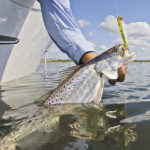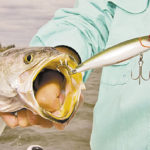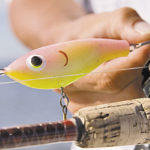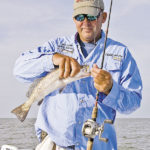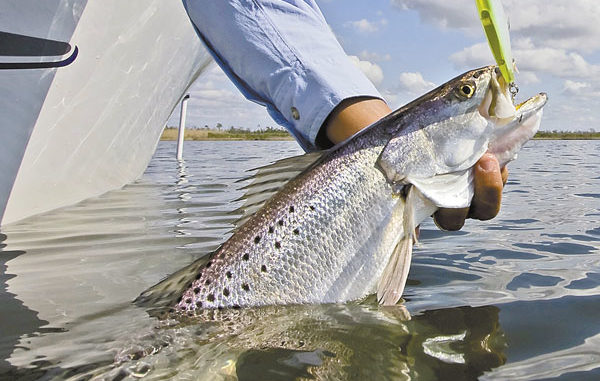
It’s the holiday season, and that means Calcasieu Lake speckled trout are hitting the hard stuff.
Calcasieu Lake was a lot quieter back in 1985 when Capt. Jeff Poe first moved to Louisiana and settled on its shoreline. That doesn’t mean the speckled trout fishing was any better or any worse back then; it just means that the only way people could find out about what was going on was by telephone or through the mail.
By the late 1980s or early ’90s, Poe, who operates Big Lake Guide Service (337-598-3268), had started to figure out that these particular trout could frequently be fooled by a bevy of baits that weren’t slithery, slimy and smelly.
Hard baits were hardly heard of at the time, and other than some Texans showing some love for the 52M MirrOlure, few anglers threw anything other than live bait at the time.
Poe started figuring out way back then that these hard baits designed to be fished below the surface rather than on it were worth his time, and he began to perfect his techniques for catching big Calcasieu Lake speckled trout before everybody else jumped on the bandwagon.
Because the paparazzi-like publicity of the lake’s giant trout was yet to come, Poe and his peers were able to catch limits of huge fish in relative anonymity on baits made from a material that few were using. Poe would never claim to be the first to fish hard plastic baits at Calcasieu Lake way back then, but he has since become one of the masters.
“If you add in topwaters,” he said, “hard baits are now one of the most popular ways to fish Calcasieu Lake. But something happens during the winter that makes the trout not too keen to come to the surface. Give them something just under the surface, though, and you could possibly catch 15 fish all over 4 pounds.”
The kinds of baits that Poe is talking about are those hard plastic baits that are shaped like saltwater baitfish with a line tie on their noses and treble hooks hanging beneath their bellies. Although this category of baits is frequently referred to as suspending baits, most of them either rise slowly to the surface or sink slowly to the bottom if allowed to sit still.
Most anybody who has had the good fortune to share a boat with Poe when the hard-bait bite was on knows he has a soft spot for the old, original, jointed Storm Thundersticks. However, he has also become a big fan of MirrOlure Catch 2000s. Excluding topwater baits, these are the two hard baits that Poe throws most frequently.
“Those are the hard ones,” he said. “That Corky is getting awfully popular over here, too. I throw the regular Corky, the Corky Devil and the Fat Boy. As far as colors go, I stick with the basics with the Thunderstick and Catch 2000 — silver/blue, silver/black and mullet.
“But when I throw the Corky stuff, I go with the bright colors like electric chicken, the pinks, oranges and that kind of stuff. Now I will tell you that you can get that Thunderstick in a rainbow trout looking color, and I’ve caught a lot of fish on that color.”
While these kinds of hard baits are likely to catch a trout just about any time of year, Poe says they really start to shine once the water gets cold and clear. Big trout invade flats from 1 to 3 feet deep to eat big mullet that move onto these flats to take advantage of the little bit warmer water they offer.
Because he believes the mullet and trout are attracted to this warmer water, Poe typically fishes hard baits on the shallow flats later in the afternoon after the sun has had a chance to do its work.
“I’ve caught them first thing in the morning,” he said, “but my best days always seem to be when I’m fishing the afternoon. And if I can get a high or incoming tide during the afternoon, that’s when it really gets good for me.”
To find a spot that he thinks is worth fishing, Poe pulls onto a flat that shows some signs of mullet. Whether he can see them on the surface or running in schools along the bottom in the clear water, he knows where he sees one or two, there are many more.
Rather than troll across the flat, Poe sets up so that the wind will push him across the target area in such a way that he never even has to deploy his trolling motor. As he drifts, Poe quickly fishes his hard baits out of both sides of his boat.
“I keep moving quickly until I hit something — catch a trout, see a fish spook off the bottom even if it is a redfish — and then I slow down,” he said. “Then on every bite I get once I slow down, I’ll drop anchor unless (the wind) is just dead still. From there, I cover the area by fan-casting all the way around my boat.”
Like most every good angler on the water, Poe lets the fish tell him how to fish his hard baits each day he’s on the water. However, his most productive retrieve when fishing the Thunderstick is a slow and steady pull while giving it a few subtle twitches as it swims back in.
With a Catch 2000, Poe compared his most productive retrieve to the typical walk-the-dog action anglers impart to a topwater lure. He likes the basic twitch-twitch-pause retrieve that makes the Catch 2000 walk from side to side while under the water.
“I like the Thunderstick, Catch 2000 and Corkies,” Poe said, “but you can throw any of the baits that fall into these categories. The MirrOdine works well, and there are several others. The main thing is to find a bait that you can work slowly at a shallow depth.”
Although Poe sticks with monofilament line for most all of his fishing, he admits he has some braided line on one of his reels for the first time ever. Poe’s son Nick uses braided line all of the time, and he finally convinced his dad to give it a try.
He’s not too sure about it yet, but Poe says braid may wind up working well for him when fishing hard baits because of its propensity to float, and he believes it might allow him to keep his hard baits just inches under the surface at the slowest of retrieves.
And Poe chooses to fish his suspending baits on a medium-light Waterloo rod because the light action gives him better feel than a heavier-action rod would, and the light action acts as sort of a shock absorber that helps him keep from pulling treble hooks out of a trout’s mouth.
The best hard-bait fishing is usually found between Commissary Point and Turner’s Bay to the north, but Poe says he’s not willing to resolutely say that this is where anglers should be fishing this year.
“Usually you can go to any bank in that part of the lake and catch trout on hard baits,” he said. “Any shallow flat just off a bank up there will have trout at one time or another, but with all this fresh water we’ve been getting, I would be afraid to say that’s where somebody should fish, especially since we could get more at any time. Where somebody should fish will depend on how little or how much rain we get in December.”
Less fresh water means the typical spots in the northern section of Calcasieu Lake will be best. However, any more rains like Southwest Louisiana experienced back in late October will freshen this part of the lake too much, and the bite will move farther to the south and over by the Ship Channel where trout can get close to the salt water. Long Point and West Cove would be two good places to try in that case.
What Poe has discovered over the years is the more the world changes around him, the more the hard-bait bite on Calcasieu Lake stays the same. He’s been on this bite since Madonna was a Material Girl, and the paparazzi-style coverage of her and the hard-bait bite at Calcasieu hasn’t changed either.
